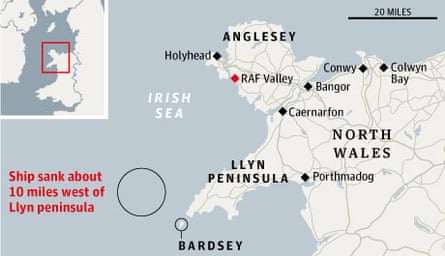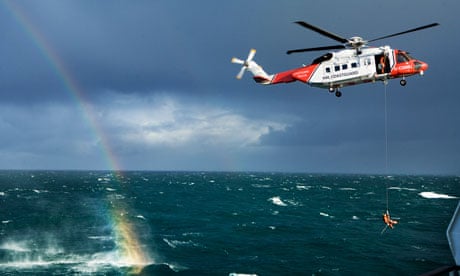Five crew from a cargo ship are feared dead after a huge wave snapped the vessel's hull in stormy seas off the coast of north Wales. Two men were rescued by an RAF helicopter co-piloted by Prince William.
The 81-metre Swanland sank almost immediately 10 miles west of the Llyn peninsula following a distress call at 2am on Sunday.
The body of one crew member has been recovered and there were fears for the fate of the five others as night fell.
While some of them were believed to be wearing survival suits, given sea temperatures of around 13C they would not be expected to survive in the water beyond six hours, the coastguard said.

Two other crew members were rescued from the water by an RAF Sea King helicopter dispatched from RAF Valley in nearby Anglesey. The men were taken to hospital in Bangor.
A Ministry of Defence spokesman explained the role played by Prince William, who is based at RAF Valley as a flight lieutenant trained in search and rescue work. He said. "It was a four-man crew – captain, co-pilot, radar operator and winchman – and he was the co-pilot. The weather conditions were described as extremely bad, with poor visibility and strong winds."
The two rescued sailors said the ship had sunk quickly in stormy weather of gale force eight and above.
Ray Carson, the watch manager at Holyhead coastguard, said: "One of the survivors said that there were five of them on deck at the time, wearing survival suits because of the conditions, and there were three either below or within the accommodation.
"He described a huge wave rolling the ship, and she broke her back. It was a catastrophic failure, and she obviously sank very quickly after that."
Carson said: "The two men recovered from the water were brought here before going to the hospital. I think they are OK and are just suffering from shock.
He said the rescue undertaken by the Sea King crew would have involved considerable skill: "It would be quite a feat given the conditions. As well as keeping a helicopter stable in the winds they had to winch someone down to a liferaft moving around in the water."
Prince William spent 19 months training as a search and rescue pilot, qualifying in September last year.
Two other cargo vessels in the area at the time played a key role in saving the two sailors. A tanker, the Bro Gazelle, was very close to the Swanland when it sank and helped provide shelter and light before the helicopters and lifeboats arrived. Another vessel, the Monsoon, spent the night searching for survivors.
The search, now covering 300 square miles, has been expanded to include four helicopters, from both RAF bases and the Dublin coastguard, as well as the Pwllheli and Porth Dinllaen all-weather lifeboats and two inshore lifeboats. An Irish navy boat has also joined the operation.
Carson said two liferafts had been spotted in the water. One was presumed to be empty, as it was the raft to which the survivors had clung. The other has washed up under cliffs at the tiny island of Bardsey and was inspected at close range by a helicopter winchman who saw no signs of life.
The stretch of water is notoriously rough, he said. In January 1991 another cargo ship, the Kimya, was capsized by giant waves in a similar location, causing its consignment of palm oil to leak into the sea. The Swanland, with a gross weight of 1,978 tonnes, was carrying limestone from Raynes Jetty near Colwyn Bay to Cowes on the Isle of Wight.
Reportedly built in the Netherlands and registered to the Cook Islands, the ship is believed to be operated by a company based in Grimsby. Last summer the Swanland came close to going aground on rocks at Lizard Point, Cornwall. The crew ship suffered engine failure in high winds as it carried a cargo of stone on 20 August.
A rescue helicopter was put on standby and a lifeboat was at the scene but Falmouth Coastguard's emergency towing vessel then managed to bring the ship to safety. No-one was injured.
